Extensions to Mendelian inheritance
1/29
There's no tags or description
Looks like no tags are added yet.
Name | Mastery | Learn | Test | Matching | Spaced |
|---|
No study sessions yet.
30 Terms
describe the different types of dominance
complete - one allele is dominant to another
incomplete - alleles are incompletely dominant relative to each other (mixing)
codominant - alleles are codominant relative to each other
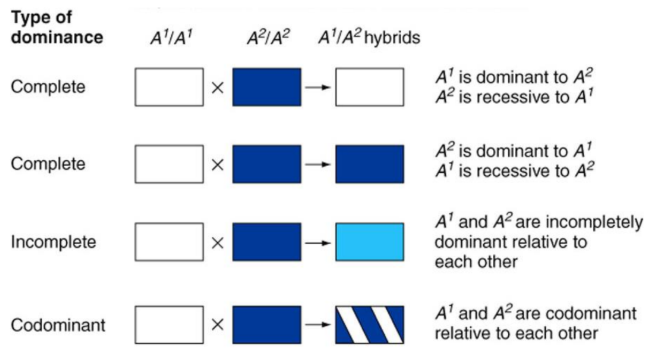
what is some information about codominance
both traits are visible in the heterozygote
expression of two different alleles for a locus occurs
if two heterozygotes have children, genotypic & phenotypic ratios = 1:2:1
what is overdominance
the heterozygote has characteristics that are better for survival/reproductive success in a particular environment then either homozygote
what are de novo mutations
mutations that are present in children but not in the parents of the children - new mutations
what is mosaicism & 2 different types
de novo mutation that is expressed early in development leads to cells differing in genetic make-up
somatic mosaicism: present in some cells but not gametes
germ-line mosaicism: restricted to the gamete lineage
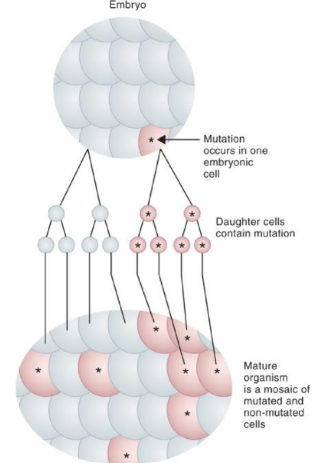
what is a lethal alleles
one that has the potential to cause the death of an organism
sometimes in utero
variants of essential genes
2:1 phenotypic & genotypic ratio (since 1 variants results in death)
what is penetrance
the proportion of carriers that will have any phenotypic expression
individuals have same genotype as their family but don’t express the phenotype
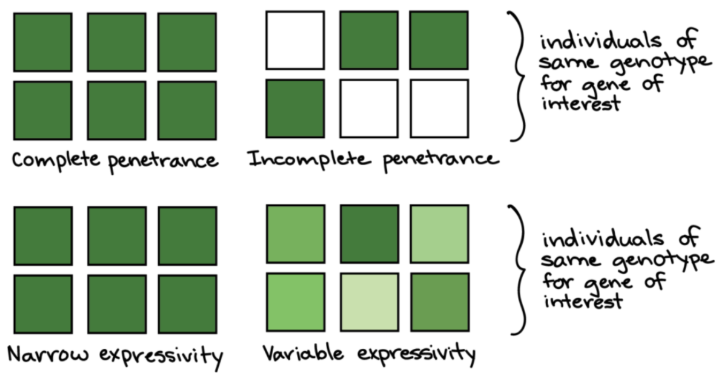
what is reduced/incomplete penetrance
when the frequency of expression of a phenotype is >100%
individual with disease genotype doesn’t show the phenotype but can pass it on
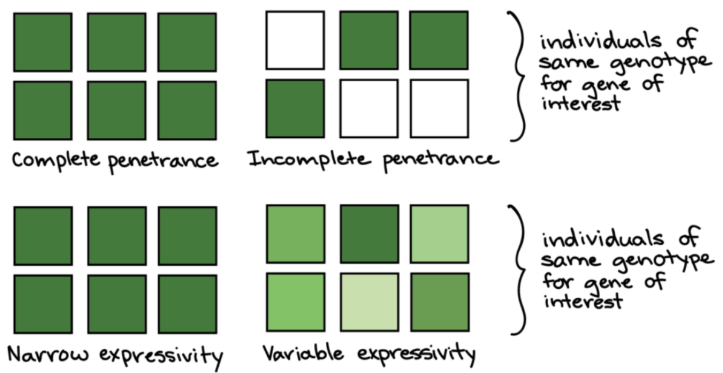
what is variable expressivity
the severity of expression of the phenotype among individuals with the same disease-causing genotype
penetrance: light (on/off?)
expressivity: how bright?
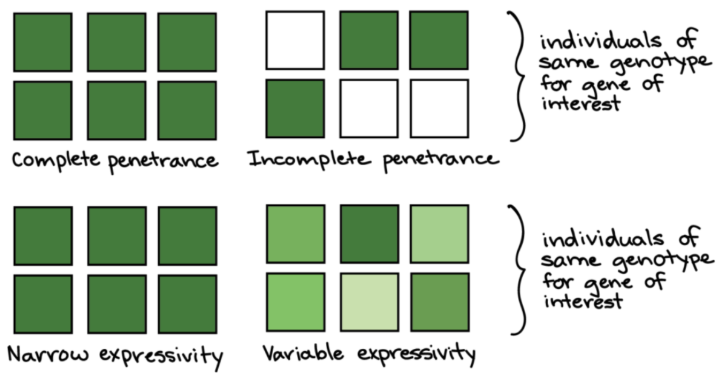
what is pleiotropy
one variant has multiple phenotypic effects
most variants are pleiotropic
genes have different function depending on cell location
what is genetic heterogeneity & 2 types
a single disease phenotype can be caused by variants are different alleles or loci in different families
allelic heterogeneity: different variants within a gene/locus can be seen in different patients with a certain genetic condition
locus heterogeneity: same clinical phenotype can result from variants at any one of the several different loci that lead to disease
what is a complementation test
a test conduct to determine if variant alleles in the same gene or different genes
how can you interpret the results of a complementation test
when organisms homozygous for variants that show the same phenotype but are in different genes are crossed, the progeny are wild-type
variants complement one another
locus heterogeneity
when organisms homozygous for variants that show the same phenotype and are the same genes are crossed, the progeny are mutant
variants fail to complement
allelic heterogeneity

what is anticipation
a genetic trait becomes more strongly expressed or is expressed at an earlier stage as it is passed down
common in disease caused by dynamic mutations
what are dynamic mutations
a trinucleotide repeat that expands during gametogenesis and interferes with gene expression
number of repeats affected severity & age of onset
what is a dihybrid ratio
when 2 genes affect different traits, a dihybrid cross gives an F2 9:3:3:1 phenotypic ratio
what is complementary gene action
need a dominant allele for each gene to produce the trait
e.g. CcPp = purple but ccPp or Ccpp = white
distinguished by 9:7 F2 dihybrid ratio (56%:44%)

what is epistasis
the phenotype produced by a variant of one gene (epistatic allele) blocks/masks the phenotype of alleles of another gene
usually occurs as genes act in the same pathway
what is recessive epistasis
distinguishing F2 ratio = 9:3:4
a recessive epistatic allele blocks/masks phenotypic effects of alleles when it is homozygous
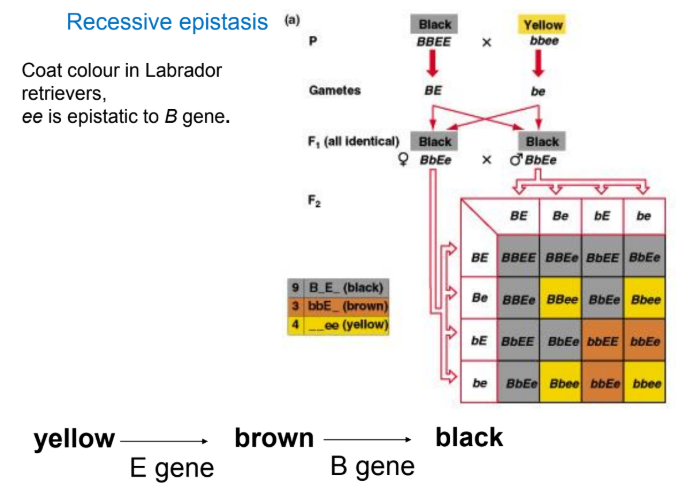
what is the Bombay phenotype
refers to an absence of substance H which binds A and/or B sugars to blood cells
present as type O
both parents would be heterozygous for lose of function in FUT1 gene
what is dominant epistasis
dominant allele at one loci masks an allele at second loci regardless of second loci allele
ratio 12:3:1
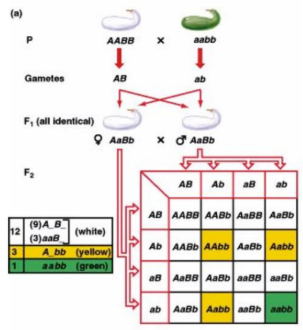
what are duplicate genes
distinguished by 15:1 F2 dihybrid ratio
either dominant alleles is required

what environmental aspects can affect phenotype
temperature
chemicals
what are sex-influenced characteristics
inherited characteristics where the same gene can be expressed differently in males & females
can be hormone influence
e.g. baldness is autosomal dominant in XY but recessive in XX
what are sex-limited characteristics
characteristics only appears/develops in one sex
e.g. ovary development & milk yield
summary of ratios

what is genomic imprinting
for some genes, one of the alleles is transcriptionally inactive
no mRNA is produced
depends on the parent from whom they received it
imprinted = transcriptionally silenced genes
imprinted genes = heavily methylated or modified chromatin of specific histone types (epigenetic changes)
what is cytoplasmic inheritance
inheritance of parental characteristics through non-chromosome DNA
mitochondrial DNA
inheritance is matrilineal (XX)
autosomal as it can affect either sex
what are the 2 types of mutations in mitochondrial DNA
homoplasmy - every mitochondrial genome carries the causative variant
heteroplasmy - contain mixed population of normal & variant genomes in each cell
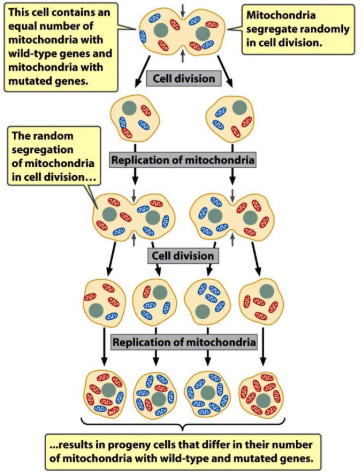
what are some pedigree characteristics of mitochondrial inheritance
all children of affected female will be affected
affected males WON’T pass it on